VecTwin Systems for Large ships
VL-VecTwin System

Outline of VL-Vec Twin System
– Background for Development –
Since 1987, Japan Hamworthy & Co., Ltd. has supplied Schilling Rudders for more than 3,000 vessels. Based on these actual results and experience, it has developed a VL-Vec Twin Rudder System this time as a new menu.
Improvement in rudder performance has come to be an important element for very large blocky ships such as VLCCs, in which importance is attached to maneuverability. It can be considered to increase rudder area in order to cope with this question, but in case of a single rudder arrangement, an increase in rudder area would not be so effective for vital necessity of improving maneuverability when a ship navigates at low speed, make rudder construction heavy, affect propulsive performance, and as the case may be, require extension of hull dimension. In addition, it makes steering gear capacity too large.
With this for a background, a new system developed is so composed that twin high lift Schilling Rudders are arranged behind a single screw propeller, respective rudder being provided with a reaction fin, and a propeller boss cap being provided with fins. Despite of less total rudder area, a VL-Vec Twin Rudder System attains remarkable improvement in safety and maneuverability for very large blocky vessels, with propulsive performance equal to, or higher than that of a single rudder arrangement, along with inherent good course-keeping quality.
Special figure of VL-Vec Twin System
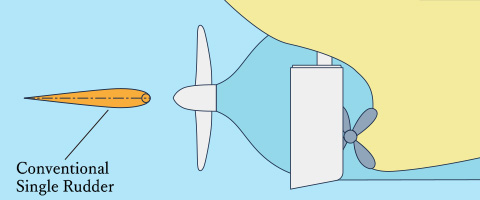
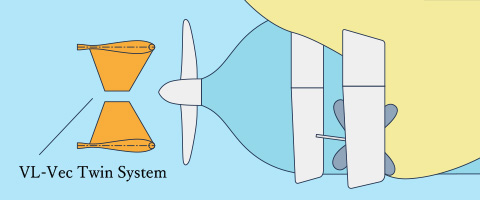
Special Characters of VL-Vec Twin System
Corresponding to design conditions such as hull dimension, propeller diameter, ship speed, etc., optimum values are set up per following items:

-
Stern Hull Form
If a VL-Vec Twin System is applied to the stern of conventional hull form suitable for a single rudder arrangement, large skegs are necessitated, causing an increase in resistance. Accordingly, a proposition for optimum stern hull form that can reduce skegs will be made.

-
Reaction Fins
Shape and attack angle of port and starboard fins will be set up in accordance with the design conditions.

-
Skeg Setting Angle
Optimum skeg setting angle will be set up.

-
Rudder Angle
Optimum rudder angle will be set up.

-
Rudder Arrangement
Distance between two rudders will be optimized.

-
Propeller Boss Cap Fins
Propeller boss cap fins(PBCF) will be designed so as to best improve propulsive efficiency.
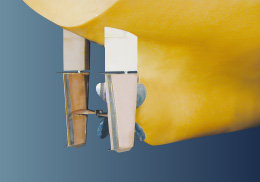
Subsidized by the Ship & Ocean Foundation and collaborated by Mitsui O.S.K. Lines and Universal Shipbuilding Corporation, the VL-Vec Twin System has been developed.
Expected Effect Obtained from VL-Vec Twin System
- Improvement in Speed-Power Performance
-
With optimization of stern hull form, reaction fins, skegs, rudder angle and distance between two rudders, and restraint of hub vortex by propeller boss cap fins, a VL-Vec Twin System will exhibit superior speed-power performance to that of a conventional single rudder arrangement.
- Improvement in Maneuverability
-
Even with less total rudder area of about 76% than that of a conventional single rudder arrangement, a VL-Vec Twin System will exhibit higher maneuvering performance and safety.
- Reduction in Sizes of Rudders and Steering Gears
-
A VL-Vec Twin System will make it possible to reduce total rudder area to about 76%, total rudder weight to about 75%, and total rudder torque to about 40%, namely, total steering gear capacity to about 40%, compared with those of a conventional single rudder arrangement. Thus rudder construction becomes light, and steering gears do with small capacity. These will give considerable economic gains.

A towing test carried out at the 240m tank of Japan Techno-mate Corporation, using a model ship of 8.6m LBP and 1.6m B.
Performance Tests and Computer Simulation on VL-Vec Twin System
- Speed-Power Performance
-
The figure shows a speed-power curve in case a VL-Vec Twin System is applied to a VLCC in comparison with a case of a conventional single rudder arrangement. The VL-Vec Twin System exhibits speed-power performance comparable to, or higher than that of the single rudder arrangement.
Speed-Power Curve[Estimated from results of the towing test at the 240m tank] 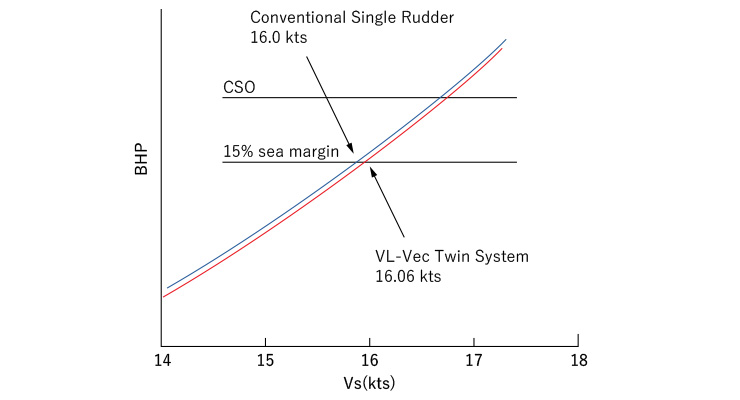
- Maneuvering Performance
-
Computer simulation on ship turning and 10°/10° zigzag maneuvering motion of a VLCC equipped with a VL-Vec Twin System was carried out, in comparison with those equipped with a conventional single rudder. It is proven that, even with less total rudder area of about 76% than that of a conventional single rudder arrangement, maneuvering performance of a VL-Vec Twin Rudder System is superior to that of a conventional single rudder arrangement.
Turning Simulation 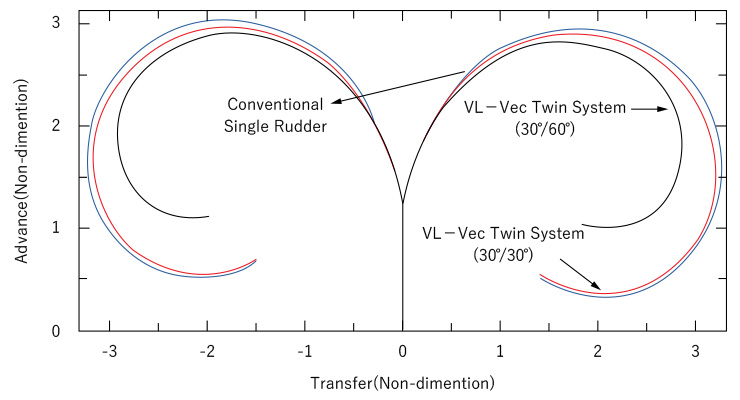
10°/10°Zigzag Maneuvering Simulation 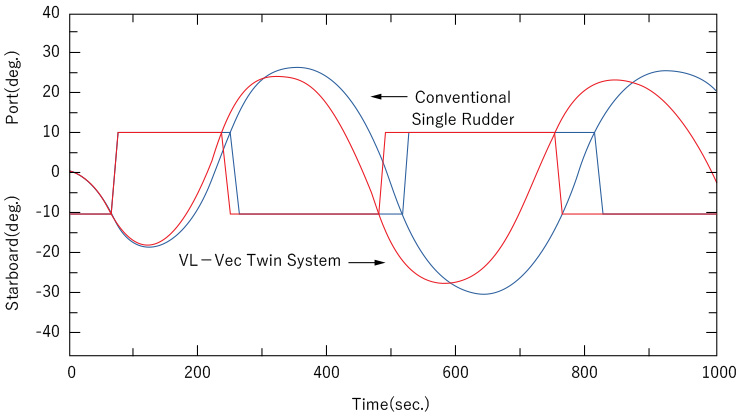
Simulation on Other Maneuvering Performance
With such configuration of a VL-Vec Twin System that twin high lift Schilling Rudders are arranged behind a single screw propeller, it is possible to give ship’s aft-body a variety of thrust in any direction and magnitude, by rudder angle combination of two rudders. Even at low speed navigation, it can develop excellent maneuvering function. Among its versatileness, when crash stopping, a ship can enter into crash astern maneuver in short time, with two rudders being operated toward outboard, respectively, so as to act as brake. Accordingly, stopping distance can be reduced on a large scale, and in addition, safety is remarkably improved as steerability is kept good even in such operation. Inertia running of a ship can be controlled.
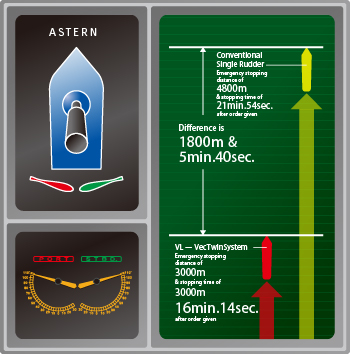
| Stopping Distance(L: Ship Length) | Stopping Time | |
|---|---|---|
| Conventional Single Rudder | 4.8km(15.0×L) | 21min.54sec. |
| VL-Vec Twin System | 3.0km(9.4×L) | 16min.14sec. |
| Difference | 1.8km(5.6×L) | 5min.40sec. |
Besides, a VL-Vec Twin System can put a ship to hovering condition, in which it keeps stop in situ, involving propulsive energy, with main engine revolution being kept in the going-ahead direction.
It also makes it possible for a ship to run at any speed lower than that corresponding to the allowable lowest revolution of a main diesel engine.
By virtue of these, freedom of maneuvering will be remarkably increased, compared with conventional very large vessels. Among other things, remarkable improvement in stopping performance and maneuvering ability at low speed will be achieved.
Furthermore, thanks to such characteristics that, not only lift of rudders is high, but also generation of the lift is quick due to quick creation of starting vortex, toe angle of offset rudder at ocean-going becomes small, and course-keeping quality will be improved.
Superiority of VL-Vec Twin System in terms of Hull Dimension
Thanks to shortened chord length of rudders of VL-Vec Twin System, hull length becomes short, compared with a case of a conventional single rudder arrangement. Otherwise, if ship length is unchanged, cubic capacity can be increased. In case of a VLCC, hull length can be shortened by about 2m, or cubic capacity can be increased by about 1%.
| Hull Length | Cubic Capacity | |
|---|---|---|
| Conventional Single Rudder | 320m | 350,000m3(at 320m L) |
| VL-Vec Twin System | 318m | 353,500m3(at 320m L) |
| Superiority | -2m | +3,500m3 |